1.2. Cutting boards
Most cutting boards are made of either hardwoods, such as
maple or walnut, or plastics like nylon or polyethylene. Regardless of which type you
get, look for ones that are at least 12″ × 18″ / 30 cm × 45 cm. Bigger is better, as
long as the board fits in your sink or dishwasher. If you choose a plastic board,
consider snagging both a rigid one, which can serve double duty as a serving board, and
a thin, flexible one, which can be used as a makeshift funnel (e.g., chop veggies, pick
up board, and curl it while sliding the food into your pan).
You can use the wrapping paper that some meats come in as an impromptu
disposable cutting board if you are just cutting something like a sausage to
sauté. One less dish to wash!
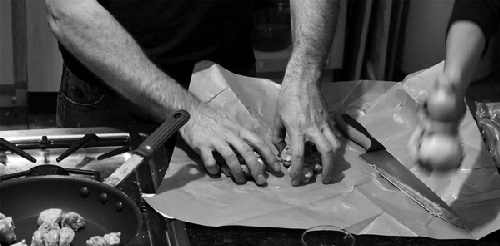
Always use two different cutting boards when working with meats: one for raw meats
and a second for cooked items. I use a plastic cutting board for raw meats and a wooden
one for after cooking because I find the difference in material to be an easy visual
reminder. I then toss the plastic cutting board into the dishwasher for cleanup. Since I
have more than two boards, I use the plastic one exclusively for raw meats.
Plastic cutting boards have the advantage of being sterilized when washed in a
dishwasher because the heated water kills common bacteria. (Don’t put your wooden
cutting board in the dishwasher, though: the hot water will damage the board.) Note that
washing a cutting board in the sink with hot water and soap is not
sufficient to remove absolutely all traces of bacteria like E.
coli. Whether wood or plastic is “safer” depends on your habits. Some studies
have shown that wood is better than plastic at preventing cross-contamination, possibly
due to chemical properties of wood, which suggests that wooden cutting boards are more
forgiving to lapses in sanitization. If you don’t have a dishwasher, current research
suggests that a wooden cutting board is the way to go.
Note:
Researchers at UC Davis found that disease-related bacteria such as E.
coli survived for a longer period of time on plastic cutting boards than
wooden ones, and that treating wooden cutting boards with mineral oil did not
materially affect the die-off rate. Additional research found that home chefs using
plastic cutting boards are twice as likely to contract salmonellosis than those using
wooden cutting boards, even when cleaning the board after contact with raw
meat.
Here are a few additional tips:
Place a bar towel or slip mat under your cutting board to prevent it from moving
while you’re working.
Some cutting boards have a groove around the edge to prevent liquids from
running over the edge. This is handy when you’re working with wet items, but it
makes transferring dry items, such as diced potato, more difficult. Keep this in
mind when choosing which board—or which side of a board—to use.
You can clean wooden cutting boards by wiping them down with white vinegar (the
acidity kills most common bacteria). If your board smells (e.g., of garlic or fish),
you can use lemon juice and salt to neutralize the odors.
Prep vegetables and fruits before starting to work on raw meats. This further
reduces the chances of bacterial cross-contamination.
1.3. Pots and pans
Which pot or pan is ideal to use for cooking an item, and how the materials in that
pot will affect the cooking process. When it comes to the metals
used in making pans, there are two key variables: how quickly the metal dissipates heat
and how much heat the metal can retain (see Metals, Pans, and Hot Spots). For new cooks, the biggest issues
are avoiding hot spots and being careful not to overheat the pan. Avoid hot spots by
using pans with materials that conduct heat well (and avoid those really cheap thin
pans). Also, don’t just automatically crank the heat up to high. Hotter doesn’t mean
faster! And if you do find yourself with a pan full of ingredients that are starting to
burn, dump the food into a bowl to halt the burning. Even off the burner, the pan will
still be hot enough to continue cooking and burning its contents.
All that being said, don’t obsess over the “perfect” pan for a job. Looking at
cladded pans (two types of metals sandwiched together) and can’t decide between copper
and aluminum? If they’re properly made (in terms of the thickness of the metal and the
construction), there won’t be a huge difference. Same thing when it comes to size and
shape.
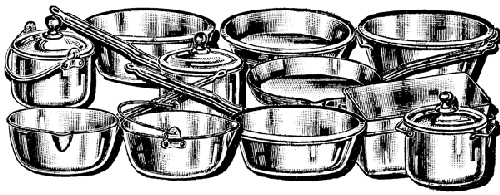
Sure, to a
professional it matters: cooking 10 pounds of onions in a narrower pot will yield more
consistent results than cooking them in a wide, shallow pan (the narrower pot will
retain water better, which assists in the cooking). But as a home chef, you’ll typically
achieve similar results in both cases, as long as you use common sense about the amount
of heat you’re using and keep a watchful eye on the pan.
As with knives, let your preferences and cooking style guide your selection of pots
and pans, and be willing to experiment and replace items to suit your needs. Avoid
purchasing a set of pots and pans, because sets often come with extra items that aren’t
quite ideal and end up wasting space and money. Instead, select each pot or pan
individually and purchase only the ones that best suit your needs. Browse your local
restaurant supply store or search for commercial products online. Commercial frying pans
are cheap multitaskers. If you’re going to splurge on a pot or pan, spring for an
enameled cast iron pan (Le Creuset is the leading maker), a good skillet, or a sauté
pan.
Note:
A skillet is technically the same thing as a frying pan, but I think of frying
pans as being the cheap-but-good commercial aluminum ones and skillets as being
stainless steel. A sauté pan is like a skillet, but the inside corners are square
instead of rounded up.
When using pots and pans, follow these tips. Unless you’re heating a pan to sauté
something, don’t absentmindedly leave it empty while it’s heating on the burner.
Overheating a pan, especially the nonstick type, will ruin the pan’s finish and possibly
warp it. Cast iron is the exception, but you still risk destroying the seasoned finish.
Also, if you’re anything like me, when you throw a dinner party the dishes often wait
until the next morning. Don’t leave pots and pans soaking in water overnight. In some
cases, the water can get “under” nonstick finishes and blister it. In the case of cast
iron, the pans will rust.
Frying pans. A frying pan is a shallow, wide pan
with slightly sloped edges. Look for frying pans that have a smooth cooking surface and
are as large as your stovetop will comfortably accommodate. If you get one that’s too
large, the burners on your stove will heat the center but not the outer region, which
will lead to uneven cooking.
Nonstick frying pans are useful for sautéing fish and for breakfast items such as
eggs, pancakes, or crepes. Using a nonstick pan for eggs or fish also allows you to
reduce the amount of butter or oil needed during cooking.
Since nonstick coatings prevent the formation of fond (the bits of food that brown
in the bottom of the pan and provide much of the flavor in sauces), you might also want
to purchase a stainless steel frying or sauté pan.
Note:
How do they get Teflon (polytetrafluoroethylene, PTFE) to stick to the pan if it
doesn’t stick to anything? By using a chemical that can actually stick to
both PTFE and the pan, called an adhesion promoter in chem-speak.
Perfluorooctanoic acid (PFOA) is the adhesion promoter of choice. Unfortunately, it’s
rather toxic, but according to the manufacturers it’s not present in the finished
products. PTFE itself melts at 620°F / 327°C. Most stoves can get pans up above that
temperature, which is why nonstick pans shouldn’t be used for searing or under the
broiler. DuPont says nonstick pans coated with PTFE are fine up to 500°F / 260°C and
that the material won’t begin to “significantly decompose” until 660°F / 349°C. Still,
don’t try it: polymer fume fever isn’t fun.
I personally use nonstick frying pans as a default for day-to-day cooking because
they’re easier to clean and well suited to the type of food I eat. My stainless steel
frying pan gets used for those times when I am cooking “for real” (not to knock my
morning scrambled eggs) and want to deglaze the pan to capture the fond. But you might
cook different foods than I do, in which case your default pan might end up being
stainless steel or cast iron.
I recommend that you have at least three frying pans on hand: one for searing items
such as fish, a second for sautéing vegetables, and a third for those times when you
want to reduce a sauce or sweat onions at a lower temperature. I prefer Vollrath’s
Lincoln Wear-Ever Ceramiguard 10″ frying pans (EZ4010): they’re cheap, they get the job
done, and the silicone handles are oven-safe. If you’re lucky enough to have a larger
stovetop with burners rated for higher BTUs, snag a 12″ / 30 cm frying pan in lieu of a
third 10″ / 24 cm pan. And, if you’re often cooking for one, a smaller 8″ / 20 cm frying
pan is a useful size for quick dishes like scrambled eggs.
You don’t need to completely wash nonstick frying pans every time you
use them, unless there’s particulate food left behind. Wipe the pan down with a
paper towel, leaving a thin layer of oil behind.
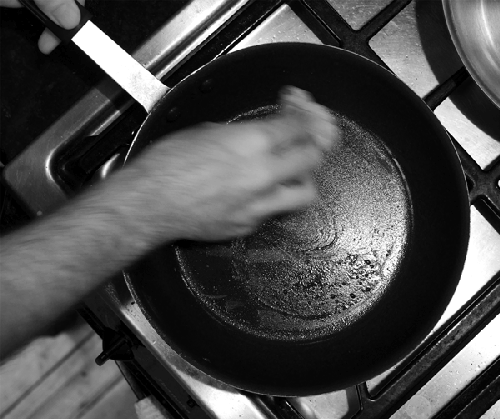
I find it useful to have multiple frying pans so that I can cook
different components of a dish separately. Onions (left pan), for example, are
often “sweated” at a lower temperature, to keep them from caramelizing, while
sausage (right pan) needs to be cooked hot enough to trigger the Maillard
reactions that give seared meats an intensely rich flavor.
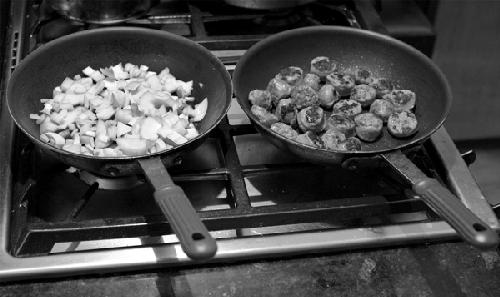
Saucepans. A saucepan, roughly as wide as it is tall and with
straight sides, holds two to three quarts of liquid and is used in cooking liquid foods
such as sauces, small batches of soups, and hot drinks like hot chocolate. Look for a
pan that has a thick base, as this will help dissipate the heat and avoid hot spots that
could burn your food. Keep in mind that many of the liquids cooked in a saucepan tend to
be things that can burn, so it’s worth spending a bit more to purchase a pan that
conducts heat better. I picked up my favorite saucepan as an “odd lot” piece from a
department store set. (Be sure to snag the lid as well!) You might prefer a
saucier pan, one that has rounded corners that are easier to get
into with a whisk or a spoon.
Stockpots. A stockpot holds two or more gallons
of liquid and is used in blanching vegetables, cooking pasta, and making soups. Since
most applications for a stockpot involve a large amount of water, burning foods is not
as much of a concern as it is with a saucepan—unless you can figure out how to burn
water! The stockpot I use is one of the $20 cheap stainless steel commercial varieties.
Make sure to pick up a lid as well, because commercial sellers tend to sell them
separately.
Cast iron pans. You should have a good cast iron
pan in your pot and pan collection. Cast iron pans are heavy, and their larger mass
allows for better retention of heat. Cast iron pans can also be heated to higher
temperatures than nonstick and stainless steel pans, making them ideal for searing foods
such as meat. They’re also handy for baking items such as corn-bread or deep-dish pizza.
Just remember to avoid cooking highly acidic items such as tomatoes in them, because the
iron will react with acidic items.
As with frying pans, when washing cast iron, don’t use soap. Instead, rinse the pan
and wipe the inside to dislodge any stuck-on food, and then place the pan back on the
stove. If the food is really stuck, throw in a few tablespoons of course salt and a
spoonful or two of vinegar or lemon juice, and “sand” it off with a paper towel. Once
your pan is clean, wipe it down with a little heat-stable oil such as canola or
sunflower oil (but not extra virgin olive oil) and place on a burner set for low heat
for a minute or so to thoroughly dry it out. And never let it sit in water for hours on
end, because the water will ruin the finish. If you do end up with
rust spots, don’t fear. You can use a metal scrubbing brush to scrape away the rust, and
then reseason the pan with a coating of oil.
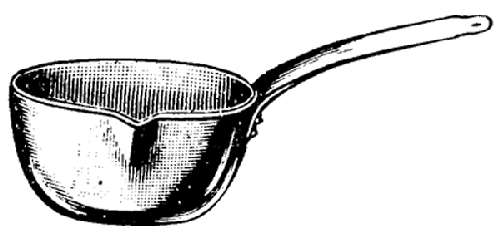
What’s the deal with pans
made of different metals or with various combinations sandwiched together? It has to
do with the differences in thermal conductivity (how quickly heat energy moves through
a material) and heat capacity (how much energy it takes to heat a material, which is
the same as how much energy it’ll give off when cooling).
Let’s start with the thermal conductivity of common metals in pans, along with a
few other materials for reference.
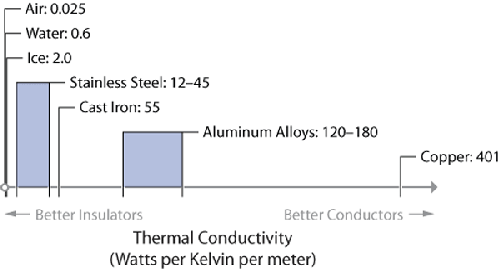
Pans made from materials with a lower thermal conductivity take longer to heat,
because the thermal energy applied from the burner takes longer to transfer up and
outward. In physics-speak, this is called low thermal response
time. In cooking, pans with low thermal conductivity (cast iron,
stainless steel) are “sluggish” in response to changes in heat. Pop them on the
burner, and nothing seems to happen for a while. Likewise, if you get them too hot and
pull them off the burner, food in them will continue to cook for a while.
Given two pans of identical diameter, one cast iron and one aluminum, the aluminum
pan will conduct the heat throughout the pan faster. Here’s a picture of this, using
thermal fax paper (hey, not all of us can afford a thermal imaging camera!). Since
thermal fax paper turns dark where heated, dark = hot and white = cold.
Cast iron pan on a gas burner = slower heat
transfer.

Aluminum iron pan on a gas burner = faster heat
transfer.

Note:
If you’re keen to try this yourself, grab a roll of thermal fax paper, heat your
pan on the burner for 30 to 60 seconds, turn off the heat, and then place a square
sheet of paper on top of the pan and coat it with a few cups of cold rock/kosher
salt to help press the paper against the surface of the pan.
Notice that the gas burner has a wide radius and the gas jets are directed
outward. Result? The center of the pan actually ends up being
colder. The cast iron pan shows this well because the heat does not conduct through
the material as quickly as it does with the aluminum pan, leading to a cold
spot.
Specific heat is important, too. Specific heat is the thermal
energy (measured in joules) needed to change a unit mass of
material by a unit of temperature, and it differs between materials. That is, it’ll
take a different amount of energy to raise a kilogram of cast
iron 1°C versus a kilogram of aluminum, because of how the materials are structured at
the atomic level. How do common metals in pans compare in terms of specific
heat?
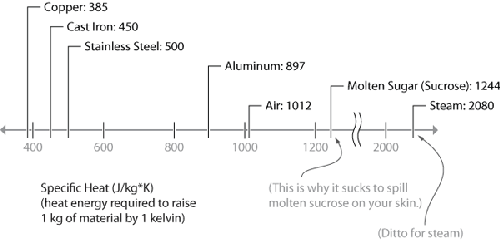
Cast iron has a lower specific heat than aluminum. It takes roughly twice as much
energy (897 J/ kg*K versus 450 J/kg*K) to heat the same amount of aluminum up to the
same temperature, and because energy doesn’t just disappear (first law of
thermodynamics), this means that a kilogram of aluminum will actually give off
more heat than a kilogram of cast iron as it cools (e.g., when
you drop that big steak onto the pan’s surface).
It’s not just the thermal conductivity or specific heat of the metal that matters,
though; the mass of the pan is critical. I always sear my steak in my cast iron pan.
It weighs 7.7 lbs / 3.5 kg, as opposed to 3.3 lbs / 1.5 kg in the case of my aluminum
pan, so it has more heat energy to give off. When searing, pick a pan that has the
highest value of specific heat * mass, so that once it’s hot, it
won’t drop in temperature as much when you add the food.
There are a few other factors you should consider when picking a pan. Cast iron
and aluminum react with acids, so pans made of those materials shouldn’t be used for
simmering tomatoes or other acidic items. Nonstick pans shouldn’t be heated above
500°F / 260°C. And then there are cases where the pan isn’t the primary source of heat
for cooking: when boiling or steaming, the water provides the heat transfer, so the
material used in making the pan isn’t important. Likewise, if you’re using an
ultra-high-BTU burner (like the 60,000-BTU burners used in wok cooking), the pan isn’t
a heat sink so heat capacity isn’t important.
What’s the deal with cladded metals? You know, pans with
copper or aluminum cores, encased in stainless steel or some other metal?
(Clad = to encase with a covering.) These types of pans are a
solution to two goals: avoiding hot spots by evening out heat quickly (by using
aluminum or copper), and using a nonreactive surface (typically stainless steel,
although nonstick coatings also work) so that the food doesn’t chemically react with
the pan.
Finally, if you’re buying a pan and can’t decide between two otherwise identical
choices, go for the one that has oven-safe handles. Avoid wood, and make sure the
handles aren’t so big that they prevent popping the pan in the oven.